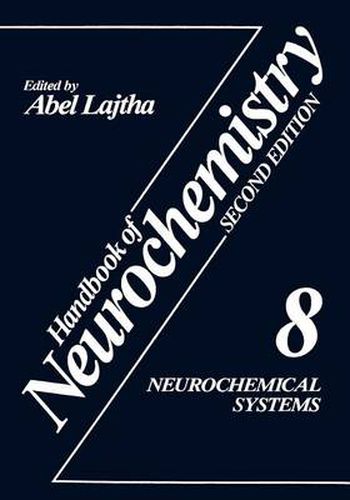Readings Newsletter
Become a Readings Member to make your shopping experience even easier.
Sign in or sign up for free!
You’re not far away from qualifying for FREE standard shipping within Australia
You’ve qualified for FREE standard shipping within Australia
The cart is loading…






This title is printed to order. This book may have been self-published. If so, we cannot guarantee the quality of the content. In the main most books will have gone through the editing process however some may not. We therefore suggest that you be aware of this before ordering this book. If in doubt check either the author or publisher’s details as we are unable to accept any returns unless they are faulty. Please contact us if you have any questions.
The content of Volume 8 of the Handbook of Neurochemistry is a perfect example and sample of what occupies neurochemists in the late 1980s. What occupies them are questions, concepts, and technology that either did not start with the nervous system, or rapidly moved out of its exclusivity (see, for in- stance, chapters on neurotensin, beta-lipotropin, behavioral and neurochemical effects of ACTH, cholecystokinin, etc.). Thus, the neurochemist is more and more seen as a biochemist occupied by questions, concepts, and technology that are not unique to the nervous system, even though the ultimate substrate of these questions, as well as the ultimate functions so studied and occasionally explained, are of the nervous system. Look at the case of the hypothalamic hypophysiotropic peptides, also called hypothalamic releasing factors, or hypothalamic releasing hormones. These are all small-to-medium-size polypeptides originally characterized in ex- tracts of the hypothalamus on the basis of bioassays directed at studying their effects on one or another of the secretions of the adenohypophysis. We know now that TRFs (See Chapter 8), the thyrotropin and prolactin releasing factor, somatostatin, the hypothalamic inhibitor of the secretion of growth hormone, as well as LRF, the hypothalamic decapeptide stimulating the secretion of pituitary gonadotropins, are to be found in parts of the brain other than the hypothalamus, where their function is obviously not hypophysiotropic. Such is also the case for CRF-the corticotropin and beta-endorphin releasing factor.
$9.00 standard shipping within Australia
FREE standard shipping within Australia for orders over $100.00
Express & International shipping calculated at checkout
This title is printed to order. This book may have been self-published. If so, we cannot guarantee the quality of the content. In the main most books will have gone through the editing process however some may not. We therefore suggest that you be aware of this before ordering this book. If in doubt check either the author or publisher’s details as we are unable to accept any returns unless they are faulty. Please contact us if you have any questions.
The content of Volume 8 of the Handbook of Neurochemistry is a perfect example and sample of what occupies neurochemists in the late 1980s. What occupies them are questions, concepts, and technology that either did not start with the nervous system, or rapidly moved out of its exclusivity (see, for in- stance, chapters on neurotensin, beta-lipotropin, behavioral and neurochemical effects of ACTH, cholecystokinin, etc.). Thus, the neurochemist is more and more seen as a biochemist occupied by questions, concepts, and technology that are not unique to the nervous system, even though the ultimate substrate of these questions, as well as the ultimate functions so studied and occasionally explained, are of the nervous system. Look at the case of the hypothalamic hypophysiotropic peptides, also called hypothalamic releasing factors, or hypothalamic releasing hormones. These are all small-to-medium-size polypeptides originally characterized in ex- tracts of the hypothalamus on the basis of bioassays directed at studying their effects on one or another of the secretions of the adenohypophysis. We know now that TRFs (See Chapter 8), the thyrotropin and prolactin releasing factor, somatostatin, the hypothalamic inhibitor of the secretion of growth hormone, as well as LRF, the hypothalamic decapeptide stimulating the secretion of pituitary gonadotropins, are to be found in parts of the brain other than the hypothalamus, where their function is obviously not hypophysiotropic. Such is also the case for CRF-the corticotropin and beta-endorphin releasing factor.